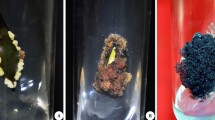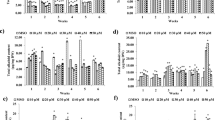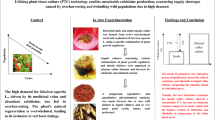Abstract
The biotechnological approach of exploiting cell culture elicitation (amendment) offers an attractive alternative strategy to overcome the limited availability of biologically active and medicinally important secondary metabolites. The present study investigated the influence of abiotic aluminum chloride (AlCl3) elicitation on alkaloid yield in Rauvolfia serpentina. This metallic ion was used to enhance the biosynthesis of reserpine in leaf-derived callus, cultured in 1.0 mg l−1 BAP + 0.5 mg l−1 IAA amended Murashige and Skoog (MS) medium and this study revealed the increased yield of reserpine in cultivated tissues. This enhanced yield could help in minimizing the indiscriminate harvest of endangered flora for natural alkaloid extraction. The elicitor’s impact on callus biomass, alteration of biochemical attributes and reserpine yield at 0.05 mM (A1), 0.10 mM (A2), 0.15 mM (A3) and 0.20 mM (A4) was evaluated at periodic intervals. Maximum callus biomass was observed in 0.15 mM AlCl3 amended medium with a highest fresh weight of 1.24 g and dry weight of 0.14 g at day 6. To understand the role of AlCl3 in plant defense mechanism, various antioxidant enzymes i.e. superoxide dismutase (SOD), catalase (CAT) and ascorbate peroxidase (APX) activities were assayed in in vitro cultivated calli with or without AlCl3 treatment. The above enzymes activities increased linearly with increasing AlCl3 level, i.e. 5.10 enzyme unit (EU) min−1 mg−1 protein SOD, 3.93 EU min−1 mg−1 protein CAT and 0.83 EU min−1 mg−1 protein APX, all being maximum at A4 treatment. The yield of reserpine was quantified in callus tissues by using HPTLC method, indicating that the reserpine synthesis was enhanced with increasing elicitor treatment up to A3 and maximum being at 0.15 mM AlCl3 amended medium (0.129 mg g−1 DW). Higher elicitation level (0.20 mM) had a very little influence on callus biomass and reserpine synthesis. Besides, the role of genes encoding pyroline-5-carboxylate synthetase (P5CS) and tryptophan decarboxylase (TDC), which participate in reserpine biosynthetic pathway is also discussed.





Similar content being viewed by others
References
Aebi H (1984) Catalase in vitro. Methods Enzymol 105:121–126
Amirjani MR (2012) Effects of cadmium on wheat growth and some physiological factors. Int J For Soil Eros 2:50–58
Bali S, Poonam, Kohli SK, Kaur H, Bhardwaj R (2016) Improvement in photosynthetic efficiency of Brassica juncea under copper stress by plant steroid hormone. J Chem Pharm Res 8(5):464–470
Baque MA, Shiragi MHK, Lee EJ, Paek KY (2012) Elicitor effect of chitosan and pectin on the biosynthesis of anthraquinones, phenolics and flavonoids in adventitious root suspension cultures of Morinda citrifolia (L.). Aust J Crop Sci 6(9):1349–1355
Bates L, Waldren PP, Teare JD (1973) Rapid determination of free proline of water stress studies. Plant Soil 39:205–207
Beljanski M, Beljanski MS (1986) Three alkaloids as selective destroyers of cancer cells in mice, synergy with classic anticancer drugs. Int Soc Cell 43:198–203
Bhatt R, Arif M, Gaur AK, Rao PB (2008) Rauwolfia serpentina: Protocol optimization for in vitro propagation. African. J Biotechnol 7(23):4265–4268
Bradford MM (1976) A rapid and sensitive method for quantification of microgram quantities of protein, utilizing the principle of protein dye binding. Anal Biochem 72:248–541
Dazy M, Masfaraud JF, Férard JF (2009) Induction of oxidative stress biomarkers associated with heavy metal stress in Fontinalis antipyretica Hedw. Chemosphere 75:297–302
Dey PM (1990) Methods in Plant Biochemistry. Carbohydarates, vol 2. Academic Press, London
Dhindsa RH, Plumb-Dhindsa R, Thorpe TA (1981) Leaf senescence correlated with increased level of membrane permeability, lipid peroxidation and decreased level of SOD and CAT. J Exp Bot 32:93–101
Dipti T, Mujib A, Maqsood M, Ali M, Zafar N (2016) Aspergillus flavus fungus elicitation improves vincristine and vinblastine yield by augmenting callus biomass growth in Catharanthus roseus. Plant Cell Tiss Organ Cult 126:291–303
Elmaghrabi AM, Ochatt S, Rogers HJ, Francis D (2013) Enhanced tolerance to salinity following cellular acclimation to increasing NaCl levels in Medicago truncatula. Plant Cell Tissue Org Cult 114:61–70
Ezeigbo I, Ezeja M, Madubuike K, Ifenkwe D, Ukweni I, Udeh N, Akomas S (2012) Antidiarrhoeal activity of leaf methanolic extract of Rauvolfia serpentina. Asian Pac J. Trop Biomed 2(6):430–432
Fatima S, Mujib A, Tonk D (2015) NaCl amendment improves vinblastine and vincristine synthesis in Catharanthus roseus: a case of stress signalling as evidenced by antioxidant enzymes activities. Plant Cell Tissue Org Cult 121:445–458
Hamel F, Breton Ch, Houde M (1998) Isolation and characterization of wheat aluminium-regulated genes: possible involvement of aluminium as a pathogenesis response elicitor. Planta 205:531–538
Harisaranraj R, Suresh K, Babu SS (2009) Production of reserpine in somatic embryos of Rauwolfia serpentina cultured in bioreactors by the induction of elicitor (Methyl Jasmonate). Global J Biochem Biotechnol 4 (2):143–147
Hayat S, Hayat Q, Alyemeni MN, Wani AS, Pichtel J, Ahmad A (2012) Role of proline under changing environments. Plant Signal Behav 7(11):1456–1466
Hussain MS, Fareed S, Ansari S, Rahman MA, Ahmad IZ, Saeed M (2012) Current approaches toward production of secondary plant metabolites. J Pharm Bioallied Sci 4(1):10–20
Ikeuchi M, Sugimoto K, Iwase A (2013) Plant callus: mechanisms of induction and repression. Plant Cell 25(9):3159–3173
John R, Ahmad P, Gadgil K, Sharma S (2008) Effect of cadmium and lead on growth, biochemical parameters and uptake in Lemna polyrrhiza L. Plant Soil Environ 54(6):262–270
Joshi N, Kumar N (2000) Aromatic and Medicinal Plants in Central Himalayas, Rauwolfia. Defence Agricultural Research Laboratory, Pithoragarh, pp 94–95
Kishor PBK, Sangam S, Amrutha RN, Laxmi PS, Naidu KR, Rao KRSS, Rao S, Reddy KJ, Theriappan P, Sreenivasulu N (2005) Regulation of proline biosynthesis, degradation, uptake and transport in higher plants: its implications in plant growth and abiotic stress tolerance. Curr Sci 88(3):424–438
Kumar VH, Shashidhara S, Anitha S, Rajesh MS (2010) Quantitative detection of reserpine in Rauwolfia serpentina using HPTLC. Int. J Pharm Pharm Sci 2(4):87–89
Kumari R, Rathib B, Ranic A, Bhatnagar S (2013) Rauvolfia serpentina L. Benth. ex Kurz.: phytochemical, pharmacological and therapeutic aspects. Int J Pharm Sci Rev Res 23(2):348–355
Kundu S, Chakraborty D, Kundu A, Pal A (2013) Proteomics approach combined with biochemical attributes to elucidate compatible and incompatible plant-virus interactions between vigna mungo and mungbean yellow mosaic India virus. Proteome Sci 11(15):1–14
Malar S, Vikram SS, Favas PJC, Perumal V (2014) Lead heavy metal toxicity induced changes on growth and antioxidative enzymes level in water hyacinths [Eichhornia crassipes (Mart.)]. Bot Stud 55(54):1–11
Mehrotra S, Srivastava V, Rahman LU, Kukreja AK (2013) Overexpression of a Catharanthus tryptophan decarboxylase (tdc) gene leads to enhanced terpenoid indole alkaloid (TIA) production in transgenic hairy root lines of Rauwolfia serpentina. Plant Cell Tiss Organ Cult 115:377–384
Mehrotra S, Goel MK, Srivastava V, Rahman LU (2015) Hairy root biotechnology of Rauwolfia serpentina: a potent approach for the production of pharmaceutically important terpenoid indole alkaloids. Biotechnol Lett 37(2):253–263
Murashige T, Skoog F (1962) A revised medium for rapid growth and bioassay with tobacco tissue cultures. Physiol Plant 15:473–497
Murthy HN, Lee EJ, Paek KY (2014) Production of secondary metabolites from cell and organ cultures: strategies and approaches for biomass improvement and metabolite accumulation. Plant Cell Tissue Org Cult 118:1–16
Mustafa NR, Kim HK, Choi YH, Erkelens C, Lefeber AW, Spijksma G, van der Heijden R, Verpoorte R (2009) Biosynthesis of salicylic acid in fungus elicited Catharanthus roseus cells. Phytochem 70:532–539
Nair VD, Panneerselvam R, Gopi R (2012) Studies on methanolic extract of Rauvolfia species from Southern Western Ghats of India—in vitro antioxidant properties, characterisation of nutrients and phytochemicals. Ind Crop Prod 39: 17–25
Nair VD, Panneerselvam R, Gopi R, Shao HB (2013) Elicitation of pharmacologically active phenolic compounds from Rauvolfia serpentina Benth. Ex. Kurtz. Ind Crop Prod 45: 406–415
Nakano Y, Asada K (1981) Hydrogen peroxide is scavenged by ascorbate specific peroxidase in spinach chloroplasts. Plant Cell Physiol 22:867–880
Namdeo AG (2007) Plant cell elicitation for production of secondary metabolites: a review. Pharmacogn Rev 1(1):69–79
Negi JS, Bisht VK, Bhandari AK, Bisht DS, Singh P, Singh N (2014) Quantification of reserpine content and antibacterial activity of Rauvolfia serpentina (L.) Benth. ex Kurz. Afr J. Microbiol Res 8(2):162–166
Nurcahyani N, Solichatun, Anggarwulan E (2008) The reserpine production and callus growth of Indian snake root (Rauvolfia serpentina (L.) Benth. ex Kurz) culture by addition of Cu2+. Biodiversitas 9(3):177–179
Panda SK, Baluska F, Matsumoto H (2009) Aluminum stress signaling in plants. Plant Signal Behav 4(7):592–597
Pandey VP, Cherian E, Patani G (2010) Effect of growth regulators and culture conditions on direct root induction of Rauwolfia serpentina L. (Apocynaceae) Benth by leaf explants. Trop J Pharm Res 9(1):27–34
Panwar GS, Guru SK (2015) Stimulation of reserpine production in the whole plant culture of Rauwolfia serpentina L. by elicitors and precursor feeding. J Plant Biochem Biotechnol 24(1):49–55
Pathania S, Randhawa V, Bagler G (2013) Prospecting for novel plant-derived molecules of Rauvolfia serpentina as inhibitors of aldose reductase, a potent drug target for diabetes and its complications. PLoS ONE 8(4):e61327
Popov SV, Vinter VG, Patova OA, Markov PA, Nikitina IR, Ovodova RG, Popova GY, Shashkov AS, Ovodov YS (2007) Chemical characterization and anti-inflammatory effect of rauvolfian, a pectic polysaccharide of Rauvolfia callus. BioChemistry 72(7):778–784
Rastgoo L, Alemzadeh A (2011) Biochemical responses of Gouan (Aeluropus littoralis) to heavy metals stress. Aust J. Crop Sci 5(4):375–383
Ray S, Majumder A, Bandyopadhyay M, Jha S (2014) Genetic transformation of sarpagandha (Rauvolfia serpentina) with Agrobacterium rhizogenes for identification of high alkaloid yielding lines. Acta. Physiol Plant 36(6):1599–1605
Rhee HS, Cho HY, Son SY, Yoon SYH, Park JM (2010) Enhanced accumulation of decursin and decursinol angelate in root cultures and intact roots of Angelica gigas Nakai following elicitation. Plant Cell Tiss Organ Cult 101:295–302
Rosa M, Prado C, Podazza G, Interdonato R, González JA, Hilal M, Prado FE (2009) Soluble sugars- metabolism, sensing and abiotic stress. Plant Signal Behav 4(5):388–393
Sivanandhan G, Aruna M, Mayavana S, Rajesha M, Mariashibub TS, Manickavasagama M, Selvarajc N, Ganapathia A (2012) Chitosan enhances withanolides production in adventitious root cultures of Withania somnifera (L.) Dunal. Ind Crops Prod 37(1):124–129
Smetanska I (2008) Production of secondary metabolites using plant cell cultures. Adv Biochem Eng Biotechnol 111:187–228
Sofo A, Scopa A, Nuzzaci M, Vitti A (2015) Ascorbate peroxidase and catalase activities and their genetic regulation in plants subjected to drought and salinity stresses. Int J Mol Sci 16:13561–13578
Susila T, Reddy GS, Jyothsna D (2013) Standardization of protocol for in vitro propagation of an endangered medicinal plant Rauwolfia serpentina Benth. J Med Plants Res 7(29):2150–2153
Thakur N, Jagota K, Shama B, Sareen N (2015) Evaluation of in vitro antifungal potential of Rauvolfia serpentina (L). Benth. ex Kurz. against phytopathogenic fungi. Int J Sci Nat 6(2):165–168
Verpoorte R, Contin A, Memelink J (2002) Biotechnology for the production of plant secondary metabolites. Phytochem Rev 1:13–25
Von Poser G, Andrade HH, Da Silva KV, Henriques AT, Henriques JA (1990) Genotoxic, mutagenic and recominogenic effects of Rauwolfia alkaloids. Mutat Res 232:37–43
Wang JW, Wu JY (2013) Effective elicitors and process strategies for enhancement of secondary metabolite production in hairy root cultures: biotechnology of hairy root systems. Adv Biochem Eng Biotechnol 134:55–89
Whitmer S, Canel C, Hallard D, Goncalves C, Verpoorte R (1998) Influence of precursor availability on alkaloid accumulation by transgenic cell line of Catharanthus roseus. Plant Physiol 116:853–857
Zahid SH, Mujib A (2012) Accumulation of vincristine in calcium chloride elicitated Catharanthus roseus cultures. Nat Prod J 2(9):307–315
Zhao J, Davis LC, Verpoorte R (2005) Elicitor signal transduction leading to production of plant secondary metabolites. Biotechnol Adv 23:283–333
Zhou LG, Wu JY (2006) Development and application of medicinal plant tissue cultures for production of drugs and herbal medicinals in China. Nat Prod Rep 23:789–810
Acknowledgements
The authors greatly acknowledge Department of Science and Technology (DST) for the financial support. The authors are also thankful to Department of Botany and Central Instrumental Facility (CIF), Hamdard University (Jamia Hamdard) for providing laboratory, instruments and other facilities.
Author information
Authors and Affiliations
Corresponding author
Additional information
Communicated by Ali R. Alan.
Rights and permissions
About this article
Cite this article
Zafar, N., Mujib, A., Ali, M. et al. Aluminum chloride elicitation (amendment) improves callus biomass growth and reserpine yield in Rauvolfia serpentina leaf callus. Plant Cell Tiss Organ Cult 130, 357–368 (2017). https://doi.org/10.1007/s11240-017-1230-7
Received:
Accepted:
Published:
Issue Date:
DOI: https://doi.org/10.1007/s11240-017-1230-7




